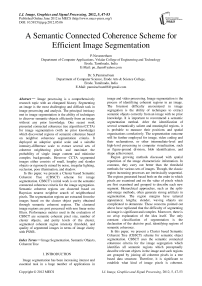A Semantic Connected Coherence Scheme for Efficient Image Segmentation
Автор: P.Navaneetham, S.Pannirselvam
Журнал: International Journal of Image, Graphics and Signal Processing(IJIGSP) @ijigsp
Статья в выпуске: 5 vol.4, 2012 года.
Бесплатный доступ
Image processing is a comprehensively research topic with an elongated history. Segmenting an image is the most challenging and difficult task in image processing and analysis. The principal intricacy met in image segmentation is the ability of techniques to discover semantic objects efficiently from an image without any prior knowledge. One recent work presented connected coherence tree algorithm (CCTA) for image segmentation (with no prior knowledge) which discovered regions of semantic coherence based on neighbor coherence segmentation criteria. It deployed an adaptive spatial scale and a suitable intensity-difference scale to extract several sets of coherent neighboring pixels and maximize the probability of single image content and minimize complex backgrounds. However CCTA segmented images either consists of small, lengthy and slender objects or rigorously ruined by noise, irregular lighting, occlusion, poor illumination, and shadow. In this paper, we present a Cluster based Semantic Coherent Tree (CBSCT) scheme for image segmentation. CBSCT's initial work is on the semantic connected coherence criteria for the image segregation. Semantic coherent regions are clustered based on Bayesian nearest neighbor search of neighborhood pixels. The segmentation regions are extracted from the images based on the cluster object purity obtained through semantic coherent regions. The clustered image regions are post processed with non linear noise filters. Performance metrics used in the evaluation of CBSCT are semantic coherent pixel size, number of cluster objects, and purity levels of the cluster, segmented coherent region intensity threshold, and quality of segmented images in terms of image clarity with PSNR.
Image Segmentation, Semantic Objects, Coherent Tree
Короткий адрес: https://sciup.org/15012301
IDR: 15012301
Текст научной статьи A Semantic Connected Coherence Scheme for Efficient Image Segmentation
Published Online June 2012 in MECS
Image segmentation has been increasing interest and essential task in a huge number of applications in image and video processing. Image segmentation is the process of identifying coherent regions in an image. The foremost difficulty encountered in image segregation is the ability of techniques to extract semantic objects correctly from an image with no prior knowledge. It is important to recommend a semantic segmentation method. After the identification of several semantically salient and meaningful regions, it is probable to measure their positions and spatial organizations correlatively. The segmentation outcome will be further employed for image, video coding and their reclamations, or other intermediate-level and high-level processing in computer visualization, such as figure-ground division, blob identification, and shape achievement.
Region growing methods discussed with spatial repartition of the image characteristic information. In common, they carry out better than the threshold methods for various sets of images. Though, the classic region increasing processes are intrinsically sequential. The regions generated based both on the order in which pixels are examined and on the value of pixels which are first examined and grouped to describe each new segment. Hierarchical approaches, such as the split-and-merge methods, often generate strong artifacts in segmentation. The region margins have tattered appearance; lengthy, slender, waving objects are complicated to demarcate. These concerns pointed out above have replicated that the difficulty of segmenting an image is significant and complex. Moreover, there is no crisp explanation of the idea itself. The only constant classification of segmentation is the declaration of the decisive goal, identifying regions of semantic coherence.
In this paper, we present a Cluster based Semantic Coherent Tree (CBSCT) scheme for semantic object segmentation. CBSCT uses the semantic connected coherence criteria for the image segregation which identifies all semantic regions which perceptually describe relevant objects in the image and such regions are grouped by joining all coherent pixels in a tree based data structure. Therefore, it is significant to establish what kind of image pixels is coherent.
Instinctively, it is helpful to believe of the perception coherence in terms of the intensity difference between locally adjacent pixels. This provides that the neighboring pixels with gradually changing intensities are coherent, while the neighboring pixels with sharp changing intensities are incoherent. Such a formulation is simple to deduce and implement.
-
II. LITERATURE REVIEW
Segmenting an image is a well-studied difficulty. A general method for segmentation clusters restricted cues such as color, texture, edges or several filter reactions, by which pixels are clustered into neighboring, consistent regions [1]. Several methods have already been presented for image segmentation, which vary from k-means method [2] to threshold approaches, to heuristic region increasing processes, and to the complicated hierarchical approaches [3].
Segmentation is also intimately connected to the problem of discovering objects from images. Since the work is so difficult, interactive results were implemented, where the user supports the segmentation process [4]. Specifically, graph-cuts optimization has verified to be a valuable apparatus for interactive image segmentation [5]. The optimization is employed to discover segmentations, which are constant with color, edges, and the user defined limitations. Graph-cuts have been expanded to hold multiple segment issues, using the alphaexpansion technique [6].
The k-means approach is the finest known and most extensively used clustering technique which is incapable to maintain unstable extended clusters, where one cluster has greatly more points than a nearest cluster [7]. In such a case, the k-means approach can speciously divide the bigger cluster into simulated sub clusters [8]. Image threshold approaches are also fashionable because of their straightforwardness and effectiveness. Nevertheless, conventional histogrambased threshold methods will not divide those areas which have the similar gray level but do not belong to the similar element [9]. Moreover, they will not process images whose histograms are almost unimodal, particularly when the indented region is much smaller than the backdrop area [10].
As described by various researchers in [11], image segmentation approaches depends on graph theoretic consequences have an improved favoring potential for satisfying the above necessities than the techniques stated above [12]. Their hierarchical natures assist the consequent processing and examination of images. Makrogiannis et al. compete that these expanded graph-based methods upcoming forth in current years employ the Gestalt principles of perceptual combining to form the image regions. They generally signify an image to be segmented as a graph. The nodes according to the image pixels, the edges (branches) express the associations between pixels by a weight that represents the (dis)-similarity of the two pixels (or regions) [13].
Our eventual intention of the research is to discover visually semantic coherent segments that have no sufficient mathematic explanation fitting well with human being visual system [14]. Therefore, several researchers presently begin from the instinct of their visual observation and decision process to establish the semantic coherence of regions. Hence, in this paper, we present semantic connected coherence criteria. Based on these criteria, CBSCT identifies various sets of coherent neighboring pixels which exploit the possibility of being a distinct physical object.
-
III. AN EFFICIENT CLUSTER BASED SEMANTIC COHERENT TREE (CBSCT) SCHEME FOR IMAGE SEGMENTATION
In this work, we establish semantic connected coherence criteria. Under such a criterion, CBSCT finds several sets of coherent neighboring pixels which maximize the probability of being a distinct physical object. At the equivalent time, it constructs each formed set into a connected coherence tree (CCT) structure as shown in figure 1. Obviously, the pixels which are not in any CCTs have considerable discontinuous intensity values. CBSCT assembles them into a residual or remaining group. In other words, CBSCT is efficient to understand an association of both segmentation of coherence region and detection of incoherence group. Furthermore, it has a nearly linear computational complexity in the number of the image pixels. Therefore, we can say that CBSCT is efficient according to Haxhimusa pointed, a graph-based segmentation algorithm is efficient if it contains a linear computational complexity in proportion to the number of image pixels.
Considering the eventual objective of image segmentation stated above, it is reasonable to evaluate the efficiency of semantic connected coherence criteria with respect to its ability of identifying the semantic coherence regions. In addition, the computational complication is another characteristic of CBSCT. Certainly, a high computation cost will strictly impede the overview of the method to broad real-time applications. Other than being efficient and competent, it is not essential that whether the method contains a fundamental idea easy to understand and execute or not. On the other hand, it would be popular if the method will offer such an essentially acceptance as well as the efficacy and effectiveness.
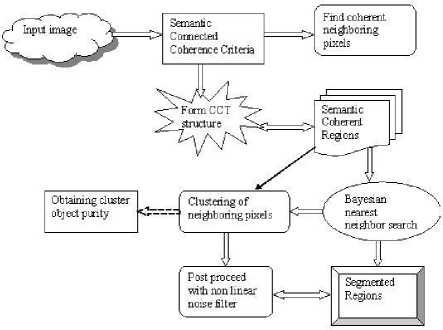
Figure 1: Cluster based Semantic Coherent Tree (CBSCT) scheme for image segmentation
From the figure (figure 1), it is clear that the image segmentation is done by identifying the semantic coherent regions of the given image. The semantic coherent regions of the image are formed by using the BNN search and segmented regions have been formed. After identifying the segmented region parts, the clustering of neighboring pixels is done through non linear noise filter and the cluster object purity is identified and processed. The processing of the segmented image is done by the CCT structure mode and the image has been segmented successfully.
-
A. Semantic Connected Coherence Criteria
If a region contains any seed pixel, it’s neighboring pixels in the set are coherent with which must be in the similar region as seed pixel. If the pixels within the similar region are related each other, it is probable that the neighbors of every pixel in this region belong to the similar part. For a reverse case, choose a pixel in a segmented region, whose neighbors frequently belong to other regions. Such a segmentation outcome is ineffective because it conflicts to the conception of image segmentation, i.e., maximizing the within-region relationship and minimizing the between-region relationship. Therefore, we stand out such a reasonable examination with the name of neighbor coherence segmentation.
If a current region contains any seed pixel, its neighboring pixels are coherent and must be segmented into the similar region as the seed pixel. More dynamically speaking, the neighbor coherence segmentation describes a transitive relationship. Explicitly, consider x ∈ seed , y ∈ seed and z ∈ seed , if z is one of the neighbors of y while y is one of the neighbors of x, together with its all neighbors is assembled into the similar region as and mutually with its all neighbors is assembled into the similar region as x. In this way, together with its all neighbors is evidently in the similar region as x.
Our Semantic Connected Coherence Criteria is provoked by the unsupervised nearest neighbor consistency in data clustering where the cluster nearest neighbor consistency works as a hypothetical base. For any data object in a cluster, its nearest neighbors must also be in the similar cluster. Our Semantic Connected Coherence Criteria verifies to the cluster consistency. The main task is to discover all points concerned in the sequence operation and then shift them all at once into a cluster or region. The contrary is that in consistency, each object is imposed to be an associate of a cluster with its s, no issue whether it is an outlier or not; whereas in our case, only the seed pixels comprise the ability to develop a region. Therefore, for image segmentation our Semantic Connected Coherence Criteria minimize the effect of noise pixels and sense the outlier or noise effectively.
-
B. Algorithm for Computing Connected Coherent Tree
Input: Image
Output: Connected Coherent Tree (CCT)
Step 1: Obtain input as image
Step 2: Compute the child pixel Cx and Coherence factor CF
C x = X ≤ threshold
C' x = X > threshold --- ( eqn 1)
CF=Cx/C' x --- ( eqn 2)
Step 3: Obtain the seed pixels
Step 4: Generate basic CCT
CCT x = C x ………… … . ( eqn 3)
Step 5: Investigates the seed pixels to continue spanning the current CCT
Y = seed ∩ (C \ {x}) … . ( eqn 4)
Step 6: Identifies all pixels and get CCT x
CCT x = CCT x ∪ ( ∪ y ∈ Y C y ) … … ( eqn 5)
Step 7: Gathers further seed pixels and Repeat step 4, 5 and 6 to generate another CCT
Sample image is taken as input in our algorithm. Child pixels and coherence factor is computed from the given image. In step 3, seed pixel is obtained. Step 4 generates the initial CCT x where the root node is the seed pixel x and its children nodes are the pixels in C x . Step 5 investigates for the seed pixels within the children nodes for further proceed spanning the present CCTx. Step 6 identifies all pixels that are accessible from the discovered children seed nodes and one final CCT with root is found out. Step 7 assembles the further seed pixels and restarts to produce another CCT. Finally, the algorithm gets terminated when all seed pixels are established efficiently.
-
IV. PERFORMANCE EVALUATION ON CLUSTER BASED SEMANTIC COHERENT TREE
Tiny objects spread over the great background in an arbitrary manner. Braga-Neto et al. implemented an object-based image analysis method based on the notion of multiscale connectivity, which will be particularly used for discovering these tiny objects hierarchically from the difficult background. Even though the approach has produced imposing outcomes for these difficult images, the inherent systematical hypothesis is too difficult to appreciate for non experts. It will obstruct its extensive application to other types of images. Our method CBSCT, however, contains a Semantic Connected Coherence Criteria which is simple to understand and realize. As a result, our CBSCT scheme flexibly deals with this kind of images.
-
V. EXPERIMENTAL RESULTS OF CLUSTER BASED SEMANTIC COHERENT TREE
Performance of Cluster based Semantic Coherent Tree (CBSCT) is evaluated by the following metrics
-
i. Semantic coherent pixel size
-
ii. Segmented coherent region intensity threshold
-
iii. Quality of segmented images in terms of image clarity with PSNR.
The experiments are taken over with the sample set of input natural image (Figure 2).
original image
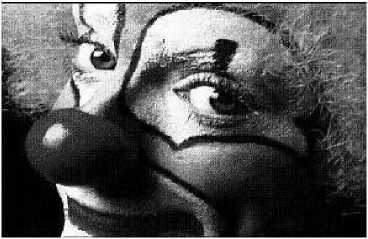
Figure 2. Input image
After obtaining the coherence factor of the given input image, semantic coherent regions are identified. Semantic coherent regions of the given input image are clustered based on Bayesian nearest neighbor search of neighborhood pixels and identified the neighborhood segmentation based pixels like figure 3.
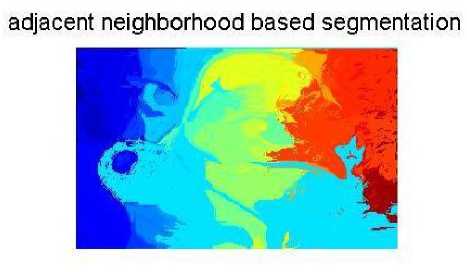
Figure 3. Neighbor based semantic coherent regions clustering
Perceptually explained appropriate substances in the image and such regions are set by combining all coherent pixels. Thus, it is important to begin what type of image pixels is rational. Automatically, it is supportive to consider of the observation coherence in terms of the strength difference between nearby contiguous pixels and created the image like figure 4.
к nearest neighborhood based segmentation
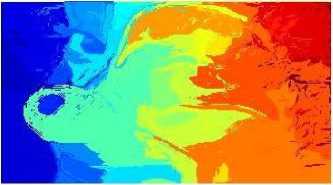
Figure 4. Clustering of neighbor pixels using BNN
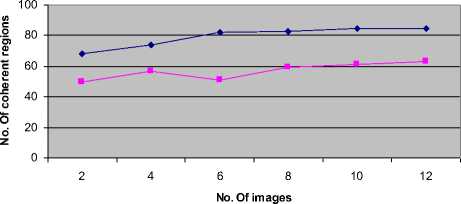
I—♦—CBSCT —■— CCTA
Figure 5. Number of coherent regions
Without stating the preferred granularity of direct over the number of coherent regions, image segmentation is an ill-posed problem. Since the segmentation of number of images produced by
CBSCT contains 68 to 85 coherent regions. It is reasonable to implement CCTA produce results with 50 to 63 regions. Then we compare CBSCT’s segmentation results with CCTA in a fair manner. Perceptibly, CBSCT performs consistently the best.
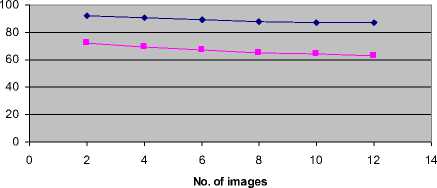
|—♦-CBSCT —■— CCTA
Figure 6. Number of images vs. Image clarity
The above figure shows the comparison result of CBSCT and CCTA in terms of Image clarity. For testing image, CBSCT excellently distinguishes the objects the complex background as a whole. CCTA fails to isolate the composite background with two or three different intensity regions. The results for images segmented by CCTA are much coarser than those by CBSCT.
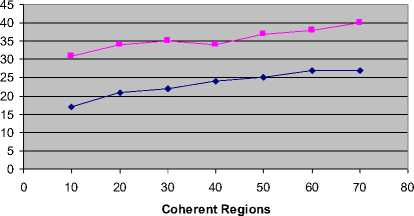
|-»-CBSCT —■— CCTA
Figure 8. Number of coherent regions vs. PSNR
Consider tiny image, some disturbing sensor and reflex noise exist in this image. CCTA separates the black noisy sky into two regions and misses the tiny object or discovers the strip of noise pixels and merges the tiny image into the sky region and snowbank region in a wrong way. CBSCT correctly finds the tiny object and achieves two apart sky and snowband regions exempted from the annoying disturbance. The results are qualitatively different, although the number of regions is identical or similar. While CBSCT does not guarantee to find the best solution, it practically performs quite well. It appears that CBSCT outperforms CCTA consistently.
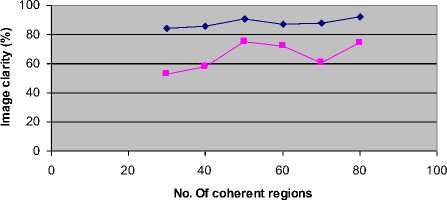
ЕЕ CBSCT —■— CCTA
Figure 7. Number of coherent regions vs. Image clarity
From the experimentation, CCTA often segments the backgrounds into many meaningless pieces, especially for tiny objects which have the white background areas. We apply our CBSCT to this problem more directly on coherent regions from natural images which come from the Berkeley Segmentation Dataset. Our proposed CBSCT performs well in which image clarity of CBSCT is good compared with CCTA.
-
VI. CONCLUSION
In this paper, we have introduced a Cluster based Semantic Coherent Tree (CBSCT) scheme for image segmentation. Initially, CBSCT have performed the semantic connected coherence criteria for the image segregation. Based on the semantic connected coherence criteria, CBSCT extracted semantic objects efficiently from an image. Bayesian nearest neighbor search of neighborhood pixels have been used to cluster the semantic coherent regions. Based on the cluster object purity obtained through semantic coherent regions, the segmentation regions have extracted from the images. The clustered image regions are post processed with non linear noise filters. Experimentation is carried out on collection of natural images to evaluate the performance of CBSCT. Performance metrics used in the evaluation of CBSCT are semantic coherent pixel size, number of cluster objects, and purity levels of the cluster, segmented coherent region intensity threshold, and quality of segmented images in terms of image clarity with PSNR.
Список литературы A Semantic Connected Coherence Scheme for Efficient Image Segmentation
- A. Achim, E. E. Kuruoglu, and J. Zerubia, "SAR image filtering based on the heavy-tailed Rayleigh model," IEEE Trans. Image Process., vol. 15, no. 9, pp. 2686–2693, Sep. 2006.
- P. Kohli, J. Rihan, M. Bray, and P. H. S. Torr, "Simultaneous segmentation and pose estimation of humans using dynamic graph cuts," Int. J. Comput. Vis., vol. 79, no. 3, pp. 285–298, 2008.
- V. Kolmogorov, A. Criminisi, A. Blake, G. Cross, and C. Rother, "Probabilistic fusion of stereo with color and contrast for bilayer segmentation," IEEE Trans. Pattern Anal. Mach. Intell., vol. 28, no. 9, pp. 1480–1492, Sep. 2006.
- Mohamed Ben Salah, Amar Mitiche, and Ismail Ben Ayed, " Multiregion Image Segmentation by Parametric Kernel Graph Cuts", IEEE Transactions On Image Processing, vol. 20, no. 2, Feb 2011.
- D. Cremers, M. Rousson, and R. Deriche, "A review of statistical approaches to level set segmentation: Integrating color, texture, motion and shape," Int. J. Comput. Vis., vol. 72, no. 2, pp. 195–215, 2007.
- I. B. Ayed, A. Mitiche, and Z. Belhadj, "Polarimetric image segmentation via maximum-likelihood approximation and efficient multiphase level-sets," IEEE Trans. Pattern Anal. Mach. Intell., vol. 28, no. 9, pp. 1493–1500, Sep. 2006.
- N. Vu and B. S. Manjunath, "Shape prior segmentation of multiple objects with graph cuts," in Proc. IEEE Int. Conf. Comput. Vis. Pattern Recognit., 2008, pp. 1–8.
- N. Y. El-Zehiry and A. Elmaghraby, "A graph cut based active contour for multiphase image segmentation," in Proc. IEEE Int. Conf. Image Process., 2008, pp. 3188–3191.
- S.Zulaikha Beevi, M.Mohamed Sathik, "A Robust Segmentation Approach for Noisy Medical Images Using Fuzzy Clustering With Spatial Probability", European Journal of Scientific Research, ISSN 1450-216X Vol.41 No.3 (2010), pp.437-451.
- Jundi Ding, Runing Ma, and Songcan Chen, "A Scale-Based Connected Coherence Tree Algorithm for Image Segmentation", IEEE transactions on image processing, vol. 17, no. 2, Feb 2008.
- Y. Haxhimusa, A. Ion, W. Kropatsch, and T. Illetschko, "Evaluating minimum spanning tree based segmentation algorithms," in Proc. CAIP, 2005, vol. 3691, LNCS, pp. 579–586.
- S. Makrogiannis, G. Economou, and S. Fotopoulos, "A region dissimilarity relation that combines feature-space and spatial information for color image segmentation," IEEE Trans. Syst., Man, Cybern. B, Cybern., vol. 35, no. 1, pp. 44–53, Feb. 2005.
- J. Ding, R. Ma, S. Chen, and B. Wang, "A fast directed tree based neighborhood clustering for image segmentation," in Proc. 13th Int. Conf. Neural Information Processing, Part II, vol. 4233, LNCS, pp. 369–378, 2006.
- Yan Nei Law, Hwee Kuan Lee, and Andy M. Yip, "A Multiresolution Stochastic Level Set Method for Mumford–Shah Image Segmentation" IEEE transactions on image processing, vol. 17, no. 12, december 2008.

